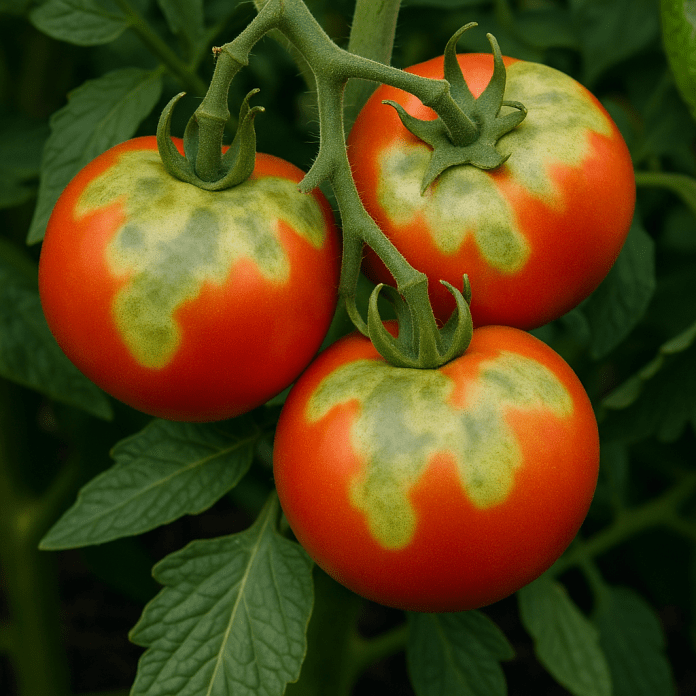Definition:
Blotchy ripening is a physiological disorder primarily observed in fleshy fruits—most notably in tomatoes (Solanum lycopersicum)—where patches of the fruit fail to develop normal coloration during the ripening process. This results in irregular, often green, yellow, or grey-green areas that remain firm and unripe, while the rest of the fruit turns its expected mature color (typically red or orange).
Symptoms:
- Irregular patches of unripe tissue on otherwise ripening fruit.
- Affected areas are often firmer and paler, lacking typical ripening pigments such as lycopene and carotene.
- In severe cases, the blotchy areas may become sunken or develop a glassy texture.
- No distinct boundary between healthy and affected tissue.
Causes:
Blotchy ripening is not caused by a single pathogen but is typically associated with a combination of environmental and nutritional factors, including:
- Nutrient Imbalance:
- Potassium deficiency is the most common cause, impairing pigment synthesis and sugar transport.
- High levels of nitrogen, especially late in the season, can exacerbate the condition.
- Environmental Stress:
- Poor light exposure due to excessive foliage or shading.
- Cool or fluctuating temperatures during the ripening period.
- Soil Conditions:
- Compacted or waterlogged soils that restrict root function and nutrient uptake.
- Cultivar Susceptibility:
- Some tomato varieties are more prone to blotchy ripening due to genetic differences in pigment development and nutrient requirements.
Diagnosis and Distinction:
Blotchy ripening should be distinguished from other disorders such as:
- Tomato spotted wilt virus (TSWV): Viral cause with concentric ring patterns and plant stunting.
- Uneven ripening due to insect feeding: Often accompanied by other signs like puncture marks.
- Yellow shoulder disorder: Similar but typically affects the upper portion (shoulder) of the fruit.
Prevention and Management:
- Balanced Fertilization:
- Ensure adequate potassium availability, especially during fruit development.
- Avoid excessive nitrogen applications.
- Improve Growing Conditions:
- Prune and space plants to allow better light penetration.
- Maintain consistent soil moisture and avoid waterlogging.
- Soil Testing:
- Regularly test soil for nutrient levels and pH to guide fertilization.
- Cultivar Selection:
- Choose varieties known for uniform ripening and resistance to physiological disorders.
Relevance to Commercial and Home Growers:
Blotchy ripening significantly reduces the marketability of fruit and can lead to post-harvest losses. Though safe to eat, affected fruit is visually unappealing and may have impaired flavor or texture. Preventive cultural practices are essential for maintaining high-quality yields.




